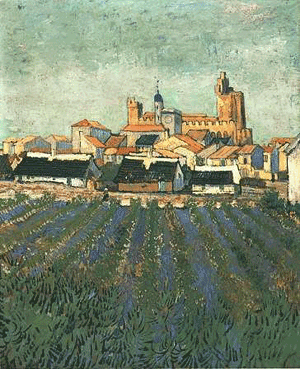The Saints
After sailing eastwards they arrived on the southern shore of Gaul Mediterranean coast close to the mouth of the Petit Rhône at the place we now know as Saintes-Maries-de-la-Mer in the Camargue According to legend:
|
Extract from The Golden Legend, written around 1260 by a Dominican, the Blessed Jacobus de Voragne, later Archbishop of Genoa. This text from William Granger Ryan (translator), The Golden Legend, 2 vols, Princeton, 1993. De Voragne has Mary arriving not in a small boat at Saintes-Maries-de-la-Mer but in a ship at Marseilles.
Mary Madelene in the Roman Prinince of Provence Some fourteen years after the Lord's passion and ascension into heaven ... the disciples went off into the lands of the various nations and there sowed the word of the Lord. With the apostles at the time was one of Christ's seventy-two disciples, blessed Maximin, to whose care blessed Peter had entrusted Mary Magdalene. In the dispersion Maximin, Mary Magdalene, her brother Lazarus, her sister Martha, Martha's maid Martilla, blessed Cedonius, who was born blind but had been cured by the Lord, and many other Christians, were herded by the unbelievers into a ship without pilot or rudder and sent out to sea so that they might all be drowned, but by God's will they eventually landed at Marseilles. (vol 1. p 376)
Mary Madelene preaches Then one day when Mary Magdalene was preaching ... (vol 1. p 377)
Mary Magdalene joins in the customary destruction and sequestration of non-Christian holy places ... they [Maximin, Mary and others] destroyed the temples of all the idols in the city of Marseilles and build churches to Christ [on the sites]. (vol 1, p 379)
Mary Magdalene retires to a local wilderness At this time blessed Mary Magdalene, wishing to devote herself to heavenly contemplation, retired to an empty wilderness, and lived unknown for thirty years in a place made ready by the hands of angels. (vol 1. page 380) |
Relics In the Middle ages, people still believed the miracle stories of works like the Golden Legend. Local monks could generally be relied on to find and dig up miraculous relics of any saint with local connections, however imaginary the saint in question. In Saintes-Maries-de-la-Mer it sounds like the monks really did find something interesting, because their discovery has a distinctly pagan ring to it. King René d’Anjou ordered the building of an oratory where the two Marys were allegedly buried in December 1448. (The crypt in which Saint Sarah stands dates from the time of these works). Excavations revealed several human heads arranged in the form of a cross and the bodies of two women. An altar of compacted earth was also found, as well as a smooth marble stone that was later to be called “the Saints’ pillow”, now on show inside the church. The discovery was taken as proof that the two bodies were the two Marys, and King René put Saintes-Maries-de-la-Mer on the pilgrim map. At a ceremony in the presence of King René and his Queen, Isabelle, the relics were placed in two reliquaries and stored in an upper chapel above the main altar. These reliquaries were destroyed at the time of the French Revolution, but local priests had apparently had the foresight to secure the relics, so that after the Revolution two new reliquaries were made, and the bones reinserted in them. Processing relics through the streets recommenced in 1862. |
|
Saint Sarah
Of the various saints supposed to have landed at Saintes-Maries-de-la-Mer the most interesting is saint Sarah, now the patron saint of the Romani (Gypsy) people. Saintes-Maries-de-la-Mer is the centre of her veneration and a place of pilgrimage for Romanies throughout the world. Saint Sarah, also known as Sarah-la-Kali ("Sarah the black", Sarah e Kali in the Romani language).
The tradition of the Three Marys arriving in France dates from the 13th century Golden Legend, but Sarah does not feature in such early accounts. Saint Sarah makes her first appearance in the sixteenth century in Vincent Philippon's book The Legend of the Saintes-Maries (1521) she is portrayed as "a charitable woman that helped people by collecting alms, which led to the popular belief that she was a Gypsy." ... which is why she was adopted by Romanies as their saint. The Legend of the Saintes-Maries now resides at the library in Arles.
In another wildly anachronistic legend Sarah was a Gypsy, camped on the shore of the Camargue when the miraculous boat approached. According to Franz de Ville (Tziganes, Brussels 1956)::
"One of our people who received the first Revelation was Sarah the Kali. She was of noble birth and was chief of her tribe on the banks of the Rhone. She knew the secrets that had been transmitted to her....The Rom at that period practiced a polytheistic religion, and once a year they took out on their shoulders the statue of Ishtari [Astarte] and went into the sea to receive benediction there. One day Sarah had visions which informed her that the Saints who had been present at the death of Jesus would come, and that she must help them. Sarah saw them arrive in a boat. The sea was rough, and the boat threatened to founder. Sarah threw her dress on the waves and, using it as a raft, she floated towards the Saints and helped them reach land."
Only later was Sarah was transferred to the boat itself. According to some accounts Sarah was a native of Upper Egypt, and was not a local but the black Egyptian maid of one of the Three Marys, usually Mary Jacobe. She had came to Palestine as the maidservant of Mary Salome and Mary Jacobe. While the women were travelling by sea a few years after the Crucifixion, they encountered a severe storm and Sarah guided the occupants of the vessel, by means of the stars, to a far-distant shore.
Other stories have Sarah as the Egyptian Abbess of a convent in Libya. In yet others she figured among a group of Persian martyrs with the two Saintes Maries and Sainte Martha, who arrived in Gaule by ship. According to one variant, citing an apocryphal text from the Eleventh Century, Sarah had been with the two Marys and Martha when they found the empty tomb of Jesus.
A Church chronicler named Raynaldus mentions in the thirteenth century that the Cathars of the Languedoc regarded Mary Magdalene as Jesus' concubine. More recent sources suggest that Jesus Christ and Mary Magdalene were married and had children, or at least one child. These ideas were popularised by The Holy Blood and the Holy Grail and Dan Brown's novel The Da Vinci Code. In “Holy Blood, Holy Grail”, it is claimed that Jesus not only had descendents who lived in what would become France, but that their blood merged with the Merovingian dynasty. Some authors, like Margaret Starbird and Tim Wallace-Murphy posited that Sarah was actually the daughter of Mary Magdalene and Jesus. According to others, Romanies worship Mary Magdalene and that it is this reason why they annually gather here.
Another thread is that of the Black Madonna. Their are many black statues of the Virgin Mary in France. These are fairly obviously adaptations of Isis, but the interesting thing is that here Mary Magdalene not the Virgin Mary is being represented as a Black Madonna.
The Church
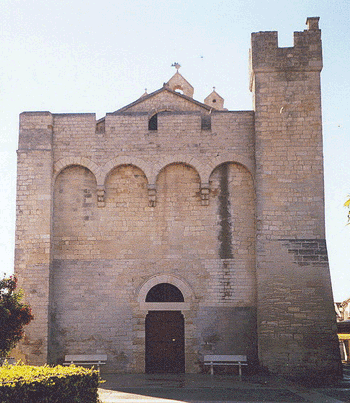
 Sources mention a church here from the 9th century, but the present building dates from the twelfth century.
Sources mention a church here from the 9th century, but the present building dates from the twelfth century.
A statue of Saint Sarah resides in the crypt of the Church of Saint Michael. Apparently, until 1912, only Romanies were permitted to enter the crypt, but now it is open to all.
To the left as you enter is an old altar, certainly a pagan altar, possibly once used to sacrifice bulls in the worship of Mithras. In the centre is a later Christian altar, dating from the Third Century. To the right, the statue of Sainte Sarah la Kali. She is fitted out in real clothes, of dubious taste, which are constantly changed. She stands on a black rock, swathed with tapestries, and placed at a height so that her devotees can easily kiss her face. A wooden monument beside her statue holds letters attesting to her many miracles. Abandoned crutches and children’s braces of are laid behind her on the rock wall (though of course there has never been an authenticated miracle here). As in pilgrimage sites of all religions, notes with written prayers are placed near the statue, along with children’s cloths, fake jewels, trinkets and naive messages.
Upstairs in the Church are altars dedicated to Mary Salome and Mary Jacobe. Relics (or rather supposed relics – scientific test are not permitted) of Mary Salome and Mary Jacob are kept and displayed.
Pelerinage des Gitans
A two day ceremony at Saintes-Maries-de-la-Mer on 24 and 25 May each year is attended by many Romany pilgrims. During this “Pelerinage des Gitans” Romanies from all over Europe head for the fortified Romanesque church at Saintes-Maries-de-la-Mer and particularly the statue of Saint Sarah in the crypt, known to the Romanies as Sarah-la-Kali. The faithful arrive in droves a week before the two days of celebration and make evening visits to the crypt accompanied by violins and guitars. Each pilgrim adds a candle to the mass of candles already lit within the shrine.
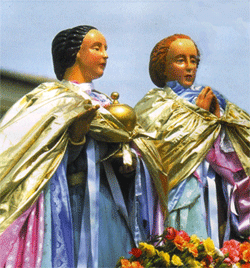
![]() On the afternoon of May 24, statues of the two Marys are lowered from the top of Saint Michael’s church. As they are lowered down the more credulous try to touch them before they reach the ground in order to receive miraculous healing and supernatural protection from misfortune. The statue of Saint Sarah is then brought up from the crypt below. The statue, blackened by the smoke of candles, is adorned in bright, new robes for the occasion. Gitans shout "Vive Sainte Sarah!" and sing hymns. She is carried on the shoulders of four gypsies, in procession winds its way through the narrow streets to the beach, escorted by gardians riding white horses. On the beach, the bearer party wade knee-deep into the water where the plaster statue of Sainte Sarah is symbolically submerged. They then turn around, go back and return the statue to the church.
On the afternoon of May 24, statues of the two Marys are lowered from the top of Saint Michael’s church. As they are lowered down the more credulous try to touch them before they reach the ground in order to receive miraculous healing and supernatural protection from misfortune. The statue of Saint Sarah is then brought up from the crypt below. The statue, blackened by the smoke of candles, is adorned in bright, new robes for the occasion. Gitans shout "Vive Sainte Sarah!" and sing hymns. She is carried on the shoulders of four gypsies, in procession winds its way through the narrow streets to the beach, escorted by gardians riding white horses. On the beach, the bearer party wade knee-deep into the water where the plaster statue of Sainte Sarah is symbolically submerged. They then turn around, go back and return the statue to the church.
At the church the three saints are venerated for the rest of the day. The following morning, the statues of the two Marys are placed in a boat also taken out to the sea, then returned and worshipped.
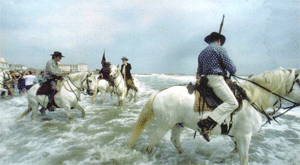
 The parade which follows the next day on 25 May in honour of the two Marys is more of a local Provençal festival, with Gypsy participation. The event offers Romani pilgrims an opportunity to renew family and social contacts, negotiate betrothals,conduct business and baptize their infants in the Church of Saintes Maries de la Mer.
The parade which follows the next day on 25 May in honour of the two Marys is more of a local Provençal festival, with Gypsy participation. The event offers Romani pilgrims an opportunity to renew family and social contacts, negotiate betrothals,conduct business and baptize their infants in the Church of Saintes Maries de la Mer.
24th May
10:00 Mass to celebrate the pilgrimage
15:30 ceremony of bringing out and parading the relics of the Marys
16:00 The statue of Sarah is paraded and taken down to see the sea
25th May
10:00 Mass of Mary Jacobé and Mary Salomé
11:00 Procession to the beach to bless the sea, with the statues of Mary Jacobé and Mary Salomé being taken down to see the sea
15:00 Sarah and the Marys all go home for their tea.
There is also a second "pilgrimage" on the sunday nearest to 22 October. This one also features the gardians, and the Marys, but not Sarah or gitans.

![]() An important pilgrim route, the Via Tolosana (marked in blue on the right) led through Arles, St-Gilles, Saint-Guilhem-le-Désert and Toulouse and crossed the Pyrenees to join other routes at Puenta-la-Reina, thence to Santiago along the Via Compostelana to Santiago de Compostela.Another route, the Regordane (marked in green), led from Le Puy-en-Velay to St-Gilles, by way of the Cévennes, Alès and Nîmes. Some pilgrims came only as far as St-Gilles, the fourth most important pilgrimage destination in Europe. Others went on to Santiago de Compostela along the Via Tolosana possibly taking a detour to Saintes-Maries-de-la-Mer (While Compostela claimed the relics of St-James, Saintes-Maries-de-la-Mer claimed the relics of his mother, Mary)
An important pilgrim route, the Via Tolosana (marked in blue on the right) led through Arles, St-Gilles, Saint-Guilhem-le-Désert and Toulouse and crossed the Pyrenees to join other routes at Puenta-la-Reina, thence to Santiago along the Via Compostelana to Santiago de Compostela.Another route, the Regordane (marked in green), led from Le Puy-en-Velay to St-Gilles, by way of the Cévennes, Alès and Nîmes. Some pilgrims came only as far as St-Gilles, the fourth most important pilgrimage destination in Europe. Others went on to Santiago de Compostela along the Via Tolosana possibly taking a detour to Saintes-Maries-de-la-Mer (While Compostela claimed the relics of St-James, Saintes-Maries-de-la-Mer claimed the relics of his mother, Mary)
The Truth
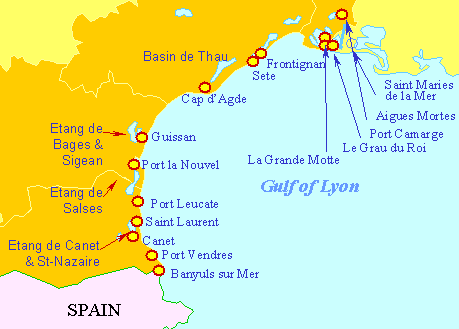
![]() The story of Sarah and the three Marys provides fertile ground for fantasists of all types.
The story of Sarah and the three Marys provides fertile ground for fantasists of all types.
Here are a few relevant pieces of information followed by a fairly obvious conclusion.
- Archaeological excavations confirm local legends that the site of Saintes-Maries-de-la-Mer has been venerated since prehistoric times, through Celtic, Greek and Roman times into the Christian era, originally focused on a holy spring.
- In Celtic times, the town was known as the Oppidum Priscum Ra. Worship to the Celtic triple water deity Matres was superseded by Roman temples dedicated to Artemis, Cybele, Isis and Mithras. Christianity sequestered many such sacred sites.
- From linguistic and genetic evidence the origins of the gypsies is now well known. They left Northern India as a group of nomads around 900 AD, reaching Persia in 950, and were in Egypt by 1230 and France by 1370.
- It is not known when and why the local church became sacred to the gypsies, but it was some time after the early 1400s.
- There were no bones of Sarah. It is her statue, not her relics, that is so paramount in the annual procession. The present statue is clearly of quite recent origin.
- Europeans imagined that Gypsies came from Egypt - the very name Gypsy comes from the word Egypt. The connection with Egypt would provide a link for folk histories involving vestigial memories of other Egyptian elements, such as Ra and Isis.
- The earliest Romanies would have been Hindus.
- Hindus worship a Hindu goddess known as Kali.
- Kālī is the feminine of kāla "black or dark coloured"
- Kali is represented as black – which would have greatly helped the confusion with identifying Sarah as a Black Madonna – which, to a large extent, Kali is indeed.
- St Sarah is also known as Sara e Kali.
- In origin Kali was a figure of annihilation, comparable to the Egyptian goddess Sekhmet. From her violent origins, Kali has now evolved into a benign Mother Goddess. Like the Virgin Mary, she is also revered as Bhavatarini, literally “redeemer of the universe”,
- The worship of Sarah at Saintes-Maries-de-la-Mer is not unique. Similar statues were worshipped by the gypsies in Eastern Europe. As Ronald Lee states: “These rituals include laying flowers at the feet of the statue, adorning the statue with clothing of the sick hoping for cures, placing requests to the statue, and lighting candles to the female divinity. To the Roma [the gypsies], Kali Sarah is the Protectress who will cure sickness, bring good luck and fertility and grant success in business ventures.” Lee added that all of these ceremonies involved carrying a statue into the nearest body of water, where a bark would also be lowered into the water – as at Saintes-Maries-de-la-Mer.
- Romani festivals are similar to the ceremony of the Durga Pooja of India, where the statue of the Goddess Durga (=Kali) is carried into water too.
- Lee’s research in other countries, including interviews with the gypsies, has confirmed that modern Gypsies were aware that “Sara-la-Kali” was none other than Kali.
- Saintes-Maries-de-la-Mer is not the only location where Gypsies have converted Kali into a Christian saint. In Mexico, Mexican gypsies are keen on The Virgin of Guadeloupe another substitute for Kali. As Lee says: “Roma all over the world continue to worship female deities or saints in shrines located near bodies of water, honouring them with ceremonies that come not from Christianity but from Hinduism.”
-

 the goddess Kali in Hindu is also known as Sarah or Sara ( TBC). In 1998, a Kali Sara festival was held in Vancouver. In 2001 a statue of her was created for her worship in Toronto. (http://home.cogeco.ca/~kopachi/articles/kscanada.html)
the goddess Kali in Hindu is also known as Sarah or Sara ( TBC). In 1998, a Kali Sara festival was held in Vancouver. In 2001 a statue of her was created for her worship in Toronto. (http://home.cogeco.ca/~kopachi/articles/kscanada.html)
So the fairly obvious conclusion is that early Christians took over an existing holy site, probably by force, as they did at thousands of other places. Again, as at other places, they Christianised it but kept elements of the original local religion. The miraculous boat story probably dates back to pagan times. Because of the Egyptian connection (Ra, Isis, Sarah) the "Gypsies" were identified with the place and incorporated their own goddess Kali into the Three Maries tale, creating Saint Sarah, one of hundreds of Christian Saints who are really ancient gods in a thin disguise.
Incidentally, and perhaps coincidentally, a further festival on 26th May features bulls, the symbol of another ancient god associated with the place, Mithras.

